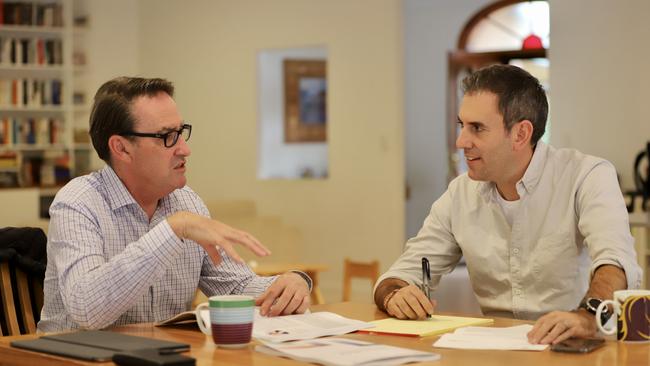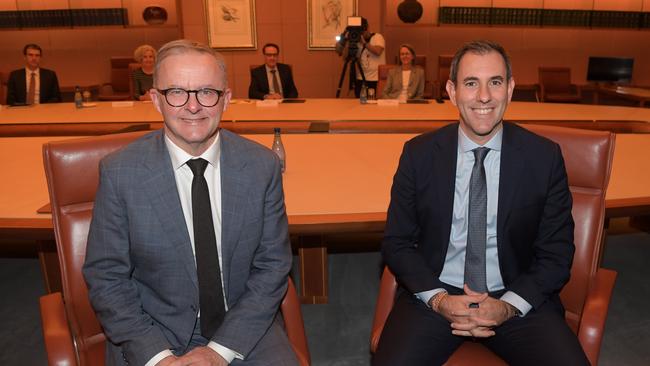Treasurer’s challenge is balancing growth, restraint and reform
Juggling multiple objectives, the Treasurer needs a budget that cements Labor’s economic authority.

This will not be a radical reforming budget. That point is widely understood. Such policy modesty is a paradox for a new government yet probably astute – this is no time for abrupt and unexpected policy gyrations. The aim is to build confidence for the long run and avoid alienating the public that is about to confront even deeper financial pain anyway.
The signals from Jim Chalmers are unmistakeable: expect the budget to be economically incremental and politically prudent. He says it should be seen as the “beginning of something” not the “end of something” – pointing to further action in the second budget in May.
There will be no shock and awe. No grand heroics. Labor wants to put down governing roots.
It will be the opposite of the first budget of the previous Liberal government, Joe Hockey’s 2014 budget which undermined the new Abbott government. Chalmers keeps talking up a national “conversation” around the economic challenges saying this will continue in his budget. It’s so adult.
Yet the time for deeds to replace words has arrived. As economist Chris Richardson told Inquirer when asked about next week’s budget: “I go immediately to Elvis: a little less conversation, a little more action, please.”
The budget begins the truth process. Anthony Albanese said this week he had worked on “tone” for the past five months, but Labor will be exposed in this document. It will constitute a critical insight into the character of Albanese Labor and the intriguing question about Chalmers’ mettle as Treasurer.
At 44, he has inherited one of the most daunting outlooks for a new treasurer: a global economy heading into what he calls a “narrower and more perilous path”; rising domestic inflation that must be contained; the political need to implement Labor’s election pledges; and giving effect to his repeated mantra that the situation demands, above all, a “responsible” fiscal framework.
The most acute contradiction is between Albanese’s election campaign around compassion and an economy that cares about people, and the grim reality of inflation heading towards 8 per cent and interest rates that will punish households, along with the imperative to demonstrate Labor has the willpower to limit spending increases, now and into the future.
The truth is Albanese was elected on a modest mandate – to deny Scott Morrison a scare campaign. The government’s dilemma now is that its limited mandate contrasts with an economy that will need substantial reform this term.
“One budget can’t fix a legacy which has got these spending pressures growing as quickly as they are,” Chalmers said this week. With economic growth slowing, his task is to bring down a budget that maintains growth, keeps any recession from the door but starts the correction of Australia’s potentially structural spending crisis.
Chief of the Business Council of Australia Jennifer Westacott told Inquirer: “I think this will be a cautious budget. No one is expecting big reform. But we need to know certain things. What’s the fiscal strategy? How are we going to balance growth against expenditure? What are the priorities? What kind of government are we getting in a fiscal and economic sense over the medium term? The budget needs to lay the ground and you would expect the May budget next year to be more ambitious.”

Juggling competing objectives, Chalmers needs a budget that establishes Labor’s economic authority. This is the overarching test. It will come with some political cost. Chalmers seeks to buttress people against inflation but he cannot deliver in the near term on Labor’s election pledges to curb cost-of-living pressures, cut power bills and restore real wages. The gap between rhetoric and delivery is large and now unavoidable.
The Peter Dutton-led opposition will run on such rhetorical failures – but Chalmers must show his budget has credibility in the right direction. Its compassion policies must be matched by a convincing fiscal strategy.
The document will reveal the sheer scale of the governing challenge facing Australia, a challenge replicated across most of the West. Witness the ignominious collapse of the Tory government in Britain with new prime minister Liz Truss forced to resign after just two months in office. Britain has a political crisis superimposed on an economic crisis.
The lesson for Australia: don’t risk foolish experiments, beware ideological utopias, chart your course, stay steady, level with people, remain flexible.
Chalmers admits that “tricky terrain” lies ahead and will require astute navigation. He says the “first priority” is inflation. The Reserve Bank has lifted interest rates six times with more to come and the budget must be seen to support the bank’s anti-inflation quest. Albanese says the task is to “alleviate” cost-of-living pressure without accentuating inflation. The budget will feature the long heralded childcare initiative, increases in paid parental leave, boosting women’s workforce participation and supporting low-paid workers.
While the haunting contrast is Hockey’s 2014 budget, there is a stunning similarity: Chalmers, like Hockey, searches to find a way to reshape the social contract – boost economic growth, restore a fiscal surplus yet deliver on the public’s social and living standards expectations. Labor won’t talk about ending “the age of entitlement”. It will avoid broken promises – witness its retention of the stage three tax cuts – and it won’t slash big spending from social programs; it will ensure its political standing is not ruined at its economic inauguration; and it will use the budget to discredit the previous government’s agenda and hack its programs.
Hockey and Tony Abbott succumbed because they attempted too much too ineptly. Will Chalmers and Albanese be judged to have done too little and squandered an opportunity. Watch for such a risk.
In simplified terms, there are two fates for this Albanese government: that it lacks the strength to change the national direction and, remaining hostage to the progressive zeitgeist and its established interest groups, that it presides over underperforming productivity, economic growth, wages and living standards – or that it constructs in office a new labour reform agenda around a fusion of growth with equity, audaciously implements reforms from the political centre and seeks to win public confidence not just on social policy but as an economic manager.
The fiscal outlook is tricky because the boom in commodity prices will deliver a deceptively strong 2022-23 bottom line but, as Chalmers highlights, when commodities return to normal price levels and structural spending pressures intensify, the fiscal risks will escalate. His message: the story is “extra pressure” in the medium term.
Economists will assess Chalmers on the budget position over that medium term and beyond. The Business Council of Australia has called for new fiscal rules, with its pre-budget statement saying real spending growth should be capped at 2 per cent annually, the difference between 2 and 3 per cent being a budget surplus over time.
The politics and economics of this Labor era will be dictated by how to solve the financial chasm in the budget – the shortfall between expanded social spending programs and their financing through the tax system, a gap that Chris Richardson and others estimate at about $40bn annually.
“The big challenge is the longer term,” Richardson said. “It is how to get closer to paying our own way. How do you repair a national social compact that’s out of whack? This is the common theme with the situation Hockey faced in 2014. We will need some combination of raising taxes and cutting spending.”
Chalmers has spelt out the numbers. Spending on the NDIS is growing at 12.1 per cent annually, with the latest blowout at $8.8bn, taking the annual cost beyond $50bn by 2025-26 – an unsustainable rate that has prompted NDIS Minister Bill Shorten to speed up a review into the scheme.
Chalmers said hospital funding was growing by 6.1 per cent, aged care by 5 per cent and defence by 4.4 per cent – while higher interest rates mean the debt servicing costs are skyrocketing.
Labor’s fate is to govern at a time of historic expansion in the social contract, a political reality the Business Council admits but says our society and political system “has not yet settled on a sustainable way to fund these services”.
This is the point made in past years and today by a range of people: Reserve Bank governors from Glenn Stevens to Philip Lowe; Treasury secretaries Ken Henry, Martin Parkinson and now Steven Kennedy; former ACCC chief Rod Sims; and a range of private sector economists.
How will Labor respond? What signals will the budget send on this question? For a start, Chalmers will need to ensure Labor’s election spending promises over four years are offset. Presumably, Labor will not succumb to the oldest trap in budget making – using temporary revenues to finance permanent spending. Any sign of that and Labor will be discredited.
In relation to the social contract, it is one thing to have social spending increasing – but not increases at the current rates. Will Labor have the resolution on this question? While attacking the “rorts” of the Morrison government, a related issue will be whether Labor puts in place reform of the grant process system.
The BCA wants a cap on tax to GDP levels to halt the “social contract” gap being filled by higher taxes overall – yet this is the precise solution being advocated by many economists, an option put on the table by the federal Treasury and is seen as inevitable by many senior Labor figures.
Pivotal to the policy and politics of tax will be any medium-term signals from Labor about its acceptance of a higher tax burden to accommodate the social contract. But this highlights the pent-up pressures that are destined to crash into the Albanese government.
For instance, if the tax burden is to rise, then tax reform is an imperative; yet comprehensive tax reform has been in the “too hard” basket for years. Chalmers and Albanese have put higher productivity in their sights. It’s essential. It is the only path to sustainable real wage gains, and so it’s a must for this ALP government. The Productivity Commission has found that “almost all wage growth since Federation appears to be due to labour productivity growth”.
Yet productivity growth is hard and elusive. Indeed, the future productivity growth trend is expected to be downgraded from 1.5 per cent to 1.2 per cent, with the BCA warning this could have a “profound impact” on economic growth.
The government intends to follow the budget with the immediate introduction of its industrial relations package presented in terms of more secure jobs and better pay. This is high risk. Data shows union claims about a rising job insecurity crisis are fraudulent, and regulating higher pay is filled with unintended consequences.
Business groups are alarmed at the prospect of multi-employer bargaining and the risk of industry-wide strikes. It is understood that reform of enterprise bargaining will be a plus. The political risk for Labor is that the bill will be seen as serving trade union interests at the cost of productivity. It may become an unfortunate lens through which the budget is interpreted.
The challenges to economic growth in Australia are daunting: population ageing, weak productivity, climate change mismanagement, and global strategic threats. In addressing these challenges, Labor cannot become hostage to progressive ideology. This government is already under sustained pressure from the left of politics on multiple fronts: to crack down harder on fossil fuels; to turn against gas as a transition fuel; to ditch the stage three tax cuts as unfair; to introduce multi-employer bargaining; to resist social spending reform; to increase taxation as a substitute for spending restraint; and to proceed down the path of more and greater government interventions.
In coming years Labor, reflecting on the failures of the Rudd-Gillard era, must decide on its chosen governing identity. With business investment still weak, the danger is that it forgets the golden rule – the path to higher productivity and higher wages is strong private sector investment, and that means a more dynamic economy. If Labor doesn’t have this vision, it is destined to underperform.
This week, Chalmers revealed the nine-year cost of the stage three tax cuts is $254bn. It sounds huge but so does any major agenda item costed over a decade. Again, he offered no defence of these tax cuts that, in effect, merely return fiscal drag and significantly simplify the system. The government, presumably, will perform surgery on this package at some point and that will become a test of Labor’s mettle: what happens to the revenue and will Labor use such reopening to engage in genuine tax reform?
The budget must be a document for the challenges Australia faces, not a Labor ideological wish list.
Can Labor transcend its ideological instincts the way the Truss government so spectacularly failed to overcome its ideological instincts? Australia is in far better shape than Britain. But the Albanese governments must now show it has the judgment to govern in a world of extreme unpredictability, volatility and risk. The moral: don’t lock in unsustainable commitments but begin to respond to the long-run challenges.




The first Chalmers budget will offer decisive signals on how the Albanese Labor government intends to redesign Australia’s social contract – an essential step given the chasm between public demand for high spending and the inadequate long-run revenue base.